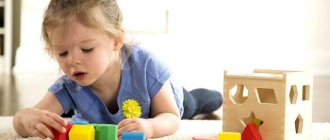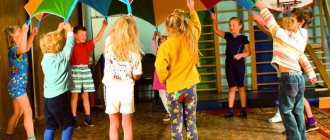The leading activity of preschool children is play. A didactic game is a verbose, complex, pedagogical phenomenon: it is both a gaming method of teaching preschool children, and a form of teaching children, and with independent play activities, and a means of comprehensive education of a child.
Didactic games contribute to : - development of cognitive and mental abilities : obtaining new knowledge, generalizing and consolidating it, expanding their existing ideas about objects and natural phenomena, plants, animals; development of memory, attention, observation; developing the ability to express one’s judgments and draw conclusions. — development of children’s speech: replenishment and activation of vocabulary. - social and moral development of a preschool child : in such a game, knowledge of the relationships between children, adults, objects of living and inanimate nature occurs, in it the child shows a sensitive attitude towards peers, learns to be fair, to give in if necessary, learns to sympathize, etc. .
The structure of the didactic game is formed by basic and additional components. The main components include: didactic task, game actions, game rules, result and didactic material. Additional components: plot and role.
Conducting didactic games includes:
1. Familiarize children with the content of the game, use didactic material in it (showing objects, pictures, a short conversation, during which the children’s knowledge and ideas are clarified).
2.Explanation of the course and rules of the game, while strictly following these rules.
3. Showing game actions.
4. Defining the role of an adult in the game, his participation as a player, fan or referee (the teacher directs the actions of the players with advice, questions, reminders).
5. Summing up the game is a crucial moment in its management. Based on the results of the game, one can judge its effectiveness and whether it will be used by children in independent play activities. Analysis of the game allows us to identify individual abilities in the behavior and character of children. This means properly organizing individual work with them.
Education in the form of a didactic game is based on the child’s desire to enter an imaginary situation and act according to its laws, that is, it corresponds to the age characteristics of a preschooler.
Types of didactic games:
1. Games with objects (toys).
2. Printed board games.
3.Word games.
Didactic games - differ in educational content, cognitive activity of children, game actions and rules, organization and relationships of children, and the role of the teacher.
Games with objects are based on children’s direct perception and correspond to the child’s desire to act with objects and thus become familiar with them. In games with objects, children learn to compare, establish similarities and differences between objects. The value of these games is that with their help children become familiar with the properties of objects, size, and color. When introducing children to nature in such games, I use natural materials (plant seeds, leaves, pebbles, various flowers, pine cones, twigs, vegetables, fruits, etc. - which arouses keen interest and an active desire in children to play. Examples of such games: “Don’t make a mistake”, “Describe this object”, “What is this?”, “What first, what then”, etc. Board and printed games are an interesting activity for children when getting acquainted with the world around them, the world of animals and plants, living and inanimate nature. They are diverse in types: “lotto”, “dominoes”, paired pictures" With the help of board and printed games you can successfully develop speech skills, mathematical abilities, logic, attention, learn to model life patterns and make decisions, and develop self-control skills.
Word games are an effective method of fostering independent thinking and speech development in children. They are built on the words and actions of the players; children independently solve various mental problems: they describe objects, highlighting their characteristic features, guess them from the description, find similarities and differences between these objects and natural phenomena.
During the games, children clarify, consolidate, and expand their ideas about natural objects and its seasonal changes.
Didactic games - travel - are one of the effective ways to enhance the cognitive activity of children.
Didactic game in experimental activities - contributes to the formation of children's cognitive interest in the environment, develops basic mental processes, observation, and thinking.
Games to develop attention
Senior preschool age
- "What changed?"
Goal: to develop voluntary attention.
Equipment : toys
Game description
Three or four toys are placed on the table (their number can be increased in the future) and the child is allowed to examine them for one to two minutes. Then ask your child to turn away while you remove one of the toys. When the baby turns at your signal, ask him what has changed? You don’t have to remove the toy, but simply swap them, without removing or changing the toys.
If the child does not understand the task of cleaning up and rearranging toys, you can talk about the order of the toys so that the child can see. When the child masters the rule, ask him to close his eyes.
If the child finds it difficult, ask guiding questions.
2. “Draw”
Goal: develop the skill of listening carefully and following the instructions of an adult.
Equipment : sheets of paper with drawn balls
Instructions:
Color the balls so that the big ball is between the green and blue, and the green is next to the red.
If the child does not understand the task, offer to color according to the sample.
If the child finds it difficult, ask leading questions.
3. “Toys go on holiday”
Target. Learn to select identical (paired) objects according to a pattern, intensify attention.
Equipment. Paired toys (two identical bears, two dolls, two hares; second set: four dolls - two pairs, different in size, two identical bears, etc.).
Progress of the game. The teacher lays out one set of toys on his table, another on the same table located at some distance and says: “Dolls, bears, bunnies want to go to the holiday in pairs, but cannot find their pairs: a bear needs the same bear, a doll needs a doll.” , bunny - bunny. Help them guys." Children take turns coming to the teacher’s table, taking one toy at a time and finding a pair for it on the next table, placing them in pairs one after another. The teacher takes a tambourine or drum, and the children move the toys around the table. The game is repeated with other children. Then each child receives one toy; at the signal from the tambourine, the children scatter around the room. Having found their mate, they march around the room with their toys.
If the child does not understand the task, help him find a pair, look at the toys, compare, find similarities
If the child finds it difficult, ask guiding questions.
4. “Who is attentive”
Target. Continue to form the perception of spatial relationships and the ability to reproduce them by imitation of the actions of an adult and according to the model; teach to carefully monitor the actions of an adult; develop the ability to independently analyze a simple sample, using not only spatial representations, but also ideas about shape, size and color.
Equipment . Builder’s kits “Color and shape”, “Build a village”, etc. according to the number of children.
Progress of the game (played individually or in subgroups). 1st option . The teacher places the child in front of him * (opposite) and lays out 4-6 builder elements. Invites the child to do as he does, performing any arbitrary design. In the process of work, he compares the position of identical elements with a gesture and clarifies their spatial arrangement. Then he builds another structure from the same elements, changing only their position. The child repeats the actions. At the end, the child’s performance of the task is assessed: “Well done, you are attentive, you built everything correctly.”
2nd option. The teacher performs construction behind the screen. The child must independently analyze the sample, highlighting the shape, size of the elements and their spatial arrangement, and reproduce the design. How a child analyzes a sample and how correctly can be judged by the process of working with the building material. The baby should not be asked any questions. If the child cannot build according to the model, the teacher moves on to imitation actions. In conclusion, the teacher evaluates the result again: “See how well you looked. You built it correctly: a large cube at the bottom, a small one at the top, a triangular roof on it, a brick next to it - you got a house with a fence.”
3rd option . Building a street to imitate the actions of an adult. The teacher places a number of elements from the “Build a Village” construction set on the table. He tells the child that they will build a street together. It delimits the place where his street and the child’s street will be. The streets should be the same. First, a two-story house is built in the middle of the street so that in the future the street can be completed in both directions - to the right and to the left. The teacher selects elements for the home in the presence of the child, encouraging him to do the same. He puts a tree next to the house. On the other side he places two trees and a car. This sequence forces the child to correctly reflect not only vertical, but also horizontal relationships - here it is no longer enough to simply reproduce the position “nearby”, you need to see on which side of the house other objects are located. Thus, the location “nearby” is clarified, differentiated (“on the other side”, “on this side”).
4th option . Construction of a street according to a model, completed in advance behind the screen. Upon completion, the construction is played out.
If the child does not understand the task, offer to complete it together.
If the child finds it difficult to offer to take a closer look at the construction.
5. “Find two identical objects”
Goal : development of thinking, attention span.
Equipment : a drawing depicting five objects, of which two objects are the same;
Description. The child is offered:
a) a drawing depicting five objects, including two identical ones; you need to find them, show them and explain the similarities between these two objects;
Instructions:
a) Look carefully at this card and find two identical ones among all the drawn objects. Show these objects and explain how they are similar.
If the child finds it difficult, ask guiding questions.
If the child does not understand the task of finding identical objects together, comparing, finding similarities.
6. “Laying out from sticks”
Goal : development of voluntary attention, fine motor skills of the fingers.
Equipment : counting sticks, pattern sample.
Description . The child is asked to lay out a pattern or silhouette using sticks.
a) 1st level of complexity - patterns in one line;
b) 2nd level of complexity - simple silhouettes, consisting of 6 to 12 sticks;
c) 3rd level of complexity - more complex silhouettes, consisting of 6 to 13 sticks;
d) 4th level of complexity - complex silhouettes with a large number of details, consisting of 10 to 14 sticks
Instructions : Look what is shown in this picture (pattern, house, etc.)? Take the sticks and make exactly the same pattern out of them (house...). Be careful when posting.
If the child finds it difficult, ask guiding questions.
If the child does not understand the task, offer to lay it out by imitation - “do as I do.”
7. “Elimination of unnecessary things”
Goal : development of attention span.
Equipment : a card with a picture of objects, one of which is different from the rest.
Description . The child is asked to find
Of the five objects shown in the picture, one is different from the others, and explain your choice.
Instructions : “Look carefully at the objects depicted here and find among them one that is different from the rest. Show the item you found and explain why it is not like the others.”
If the child finds it difficult, ask guiding questions.
If the child does not understand the task, complete the task with the child, compare, find differences.
8. “Stringing beads”»
Goal : development of concentration and attention span, fine motor skills of the fingers.
Equipment : sample for stringing beads; beads corresponding to the sample, or equally cut pieces of colored thick wire insulation; to complicate the task - large beads.
Description . The child is asked to string beads according to the pattern.
Instructions : “Look at these drawn beads. Do you want to collect the beads yourself? I will give you beads and wire on which you need to string the beads one after another exactly as they look in the picture.”
Note : Working with large beads often causes difficulties for children. It is possible to use large beads only in case of well-developed hand motor skills and as a complicating element of the game.
If the child does not understand the task, start completing the task with him, paying attention to the sequence of beads. Then offer to continue on your own.
If the child finds it difficult to ask leading questions.
9. “Copy”
Goal : development of concentration and attention span, formation of the ability to follow a pattern, development of fine motor skills.
Equipment : blank sheet of paper in a large square; sample for drawing; sharpened pencils.
Description . The child is asked to make two pictures the same
Instructions : “Look carefully at the picture. It depicts a figure consisting of lines. Draw exactly the same figure. Be careful!".
Note : It is not recommended to use a pen or felt-tip pen for drawing. If desired, the child can shade the closed figure with a colored pencil.
If the child finds it difficult, ask guiding questions.
If the child does not understand the task, complete it together with the child, showing how to do it.
The influence of outdoor games on the mental development of primary schoolchildren with mental retardation
Author of the work: The user has hidden the name, April 11, 2013 at 17:35, course work
Short description
Having analyzed the psychological and special literature on the problem of rehabilitation of primary schoolchildren with mental retardation, we found that there are several types of origin of mental development delay; they are differentiated according to the etiopathogenetic principle: constitutional, self-togenic, psychogenic and medicinal-organic origin. As a result of studying the mental processes and learning opportunities of children with mental retardation, the following features were identified: low performance, immaturity of emotions and will, a limited supply of general information and ideas, an impoverished vocabulary, undeveloped skills of intellectual activity, incompletely developed play activities.






